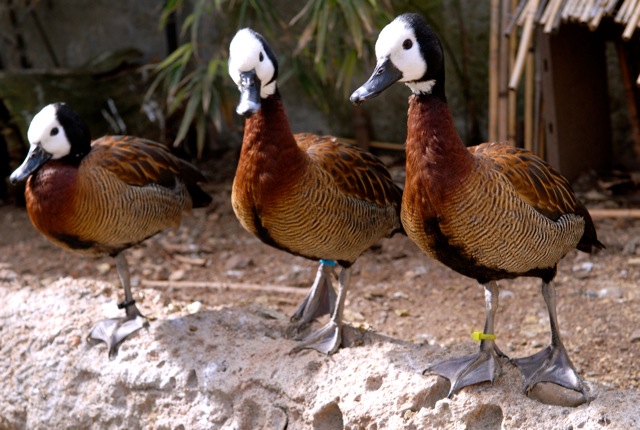

White faced Tree ducks, all in a row. |
||
|
The International Elephant Foundation (IEF) and the Association of Zoos and Aquariums (AZA) announced support for eighteen elephant conservation projects for 2011. IEF-supported projects protect elephants from poaching, seek solutions for human-elephant conflict, equip and train community conservationists, increase our knowledge of the treatment and prevention of disease and educate people. The elephants in North American zoos inspire support for the International Elephant Foundation. When someone sees, or perhaps touches, an elephant and gains a greater understanding of the animal he or she has known only from picture books and video, they are then motivated to take action to save these species from extinction. Animal collections in individual zoos and aquariums are typically too small by themselves to be of much value to long-term conservation. Therefore, cooperative international or regional ex situ breeding programs are required to form larger, viable populations. These cooperative breeding programs serve many purposes: providing animals for public educational and/or exhibit opportunities; providing fundraising material; providing research collections from which to gain basic knowledge of animal biology and husbandry; and, on a larger scale, providing demographic and genetic backup to wild populations. To serve fully in all of these roles, these populations must be viable over the long term. This requires that they be demographically stable, genetically healthy, well maintained and capable of self-sustaining reproduction, distributed among several institutions to lessen the risks of catastrophic loss and of sufficient size to maintain high levels of genetic diversity. Since the exchange of animals between regions is expensive and – mainly due to veterinary restrictions – sometimes quite difficult, conservation breeding programs are typically established and administered at the level and under the auspices of the regional associations. The measures implemented by regional associations may be limited to the collection of data (regional studbooks), they may aim to maintain a long-term ex situ population or they may be linked to in situ conservation, for example by producing animals for reintroduction into the wild.
|
Reid Park Zoo, in Tucson, AZ., is actively involved with conservation programs around the world. With help from the public they are able to address a wide range of issues that impact animals in the wild. One very creative program Reid Park uses is having the zoo keepers collect Kori bustard feathers on zoo grounds, and the feathers are then given to individuals who make fly-fishing lures. Voluntary donations from these individuals support Kori bustard conservation efforts. This is a great partnership to protect an endangered species. The Reid Park Zoo is its second year of supporting a hornbill nest adoption project in Thailand. Funds are used to hire local field assistants in Thailand to observe hornbill pairs and to record breeding behaviors and nest cavities. Reid Park participates in this project along with Woodland Park Zoo, in Seattle, Wa. The Woodland Park Zoo also has a “Fecal Fest”, which is a twice a year event where the community has the opportunity to purchase various size quantities of the famous “Zoo Doo” compost product. “Fecal Fest” is announced in September and March and prices on “Zoo Doo” run from ten dollars for a garbage can size, to sixty dollars for a truck bed full. What a great fund raising idea this is. The Salisbury Zoo, located in Salisbury, Maryland, is very good at walking the talk and operates as green as economically possible. There are recycling stations for staff and the visitors. Office paper is recycled and some paper is shredded, to be used for animal bedding. Being a small zoo, walking is the norm for staff but a John Deere Gator was purchased, to be used for larger deliveries on zoo grounds that were previously being done with a flatbed truck. This purchase has made zoo deliveries and activities easier and safer, and has reduced the gasoline consumption. >>More |
|
|
|
||
|
|
|
Copyright © 2011, Susie Christian |